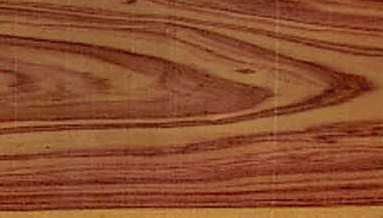   
Tulipwood (Dalbergia frutescens)
Family: Leguminosae
Common names: Bois de rose, Brazilian tulipwood, Jacaranda rosa, Pau de fuso, Pau rosa, Pinkwood, Tulipwood
Distributed in: Brazil, Columbia, Guyana, Venezuela (Central America, Latin America)
Distribution overview: Tropical South America, especially northeastern Brazil.
Common uses: Brush backs & handles, Brush backs & handles, Cabinetmaking, Flooring, Furniture , Furniture, Inlay work, Marquetry, Musical instruments, Musical instruments: percussion, Turnery, Veneer
Product sources: Round logs of Tulipwood heartwood are exported from Brazil into the United States. The logs are usually under 6 feet (2 m) long, with a diameter of 2 to 8 inches (5 to 20 cm) and are sold by the pound at very high prices. Tulipwood veneers are more available from suppliers than lumber.
Environment profile: Status has not been officially assessed
Tree size: Tree height is 20-30 m
The tree is rather small, often with an irregular trunk
Colors: the heart isRed, Redand the sapwoodWhite to yellow, Yellow.The grain isStriped figure, the textureFine to mediumand the lusterMedium
Natural durability: Non-resistant to termites, Non-resistant to marine borers
Odor: Has an odor
Tulipwood has a mildly fragrant scent when worked, but the odor disappears after machining
Drying Defects: Moderate end spitting
Risk of checking and twisting is minimal.
Ease of Drying: Fairly Easy
Comments: Compact, fissile, and splintery. It is usually marketed in the form of small logs or billets, and is primarily used for decorative purposes. Tulipwood is a familiar wood to cabinetmakers and was a popular timber for the manufacture of French furniture. Generally strong, tough, and hard. High waste factor The timber has fairly high waste factor in conversionWaste Factor
Blunting Effect: Blunting effect on machining is severe
Boring: Fairly easy to very easy
Carving: Fairly Easy to Very Easy
Cutting Resistance: Easy to saw
Gluing: Glues well
Mortising: Fairly Easy to Very Easy
Moulding: Fairly Easy to Very Easy
Movement in Service: Fairly Easy to Very Easy
Nailing: Poor to Very Poor , Pre-Boring is necessary
Planing: Very Heavy
Resistance to Impregnation: Resistant sapwood
Response to hand tools: Responds Readily
Routing recessing: Fairly Easy to Very Easy
Screwing: Fair to Good Results
; Turning: Fairly Easy to Very Easy
Polishing: Surface Preparation;
- Numerical data Metric
- Numerical data English
- Strength properties
- References
 |
 |
 |
 |
| Item |
Green |
Dry |
Metric |
| Specific Gravity |
|
0,88 |
|
| Density |
|
993 |
kg/m3 |
| Bending Strength |
|
|
kg/cm2 |
| Crushing Strength |
|
|
kg/cm2 |
| Hardness |
|
|
kg |
| Impact Strength |
|
|
cm |
| Shearing Strength |
|
|
kg/cm2 |
| Stiffness |
|
|
1000 kg/cm2 |
| Tangential Shrinkage |
|
|
% |
| Radial Shrinkage |
|
|
% |
| Weight |
|
|
kg/m3 |
| Maximum Load |
|
|
cm-kg/cm3 |
| Toughness |
|
|
cm-kg |
| Static Bending |
|
|
kg/cm2 |
|
 |  |  |  | | Item | Green | Dry | English | | Density | | 62 | lbs/ft3 | | Specific Gravity | | 0.88 | | | Weight | 60 | 50 | lbs/ft3 | |
Density (dry weight) = 61-67 lbs/cu. ft
The wood is very heavy
Brown, W.H.,1978,Timbers of the World No.1 Africa,TRADA, Red Booklet SeriesBrown, W.H.,1978,Timbers of the World, No. 2 South America,TRADA, Red Booklet SeriesKline, M. 1982. Dalbergia frutescens- Tulipwood. In A Guide to Useful Woods of the World. Flynn Jr., J.H., Editor. King Philip Publishing Co., Portland, Maine. 1994. Page 127.Kribbs, D.A. 1959. Commercial Foreign Woods on the American Market. Buckhout Lab., Dept. of Botany, The Pennsylvania State University, University Park, Pennsylvania.Kribs, D.A.,1950,Commercial and Foreign Woods on the American Market (a manual to their,structure, identification, uses and distribution,U.S.A. Penn. State College, Tropical Woods LaboratoryLincoln, W.A. 1986. World Woods in Color. Linden Publishing Co. Inc. Fresno, California.Mainieri, C.,1970,Madeiras Brasilieras,Sao Paulo Secretaria da Agricultra, Institulo Florestral
|











